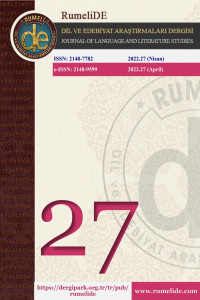Abstract
Rus edebiyat eleştirmeni ve filozof Bakhtin (1895-1975) edebiyat teorisi terminolojisine diyalojizm, çokseslilik, ve karnavalizm gibi önemli katkılarda bulunmuştur. Dostoyevski’nin çalışmalarını Dostoyevski’nin eserleri ve diğer homofonik tek sesli romanlarla arasındaki farkı incelemiştir. Bu romanlarda, karakterler oturmuş ve sabittir, ancak Dostoyevkski’nin karakterleri sonlandırılamaz ve eserdeki diğerinin sözüyle tanımlanır; bu yüzden kurgu yazar idealine değil karakterler arasındaki etkileşime göre çizilir. Rabelais ve Dünyası (1965) adlı eserinde Bakhtin iki önemli terimin altını çizmiştir: toplumsal bir kurum olarak ‘karnaval’ ve edebi bir mod olarak grotesk gerçekçilik. Karnavalizm farklı sosyoekenomik ve ırksal altyapılardan gelen insanların birlik oluşturmasını kasteden toplum kolektivitesi için kullanılır. Karnaval boyunca, bir birey maske takarak ve kostüm giyerek vücut alışverişi sayesinde yenilenir. Burda, vurgu bireyin duyusal, maddesel ve vücutsal birliği ve topluluğu üzerine olmaktadır. Vücuda odaklanarak Bakhtin karnavalı ve yeme, boşaltma ve cinsellik aracılığıyla karnavalın önemini vücutsal değişimler olarak belirleyen groteskle birleştirir. Toplumun farklı katmanlarından karakterleriyle tahmin edilemez kurguları olan ve ideal medeni yüksek-üst sınıfın altını kazan Iris Murdoch, romanlarında okuyucusuna ahlak, iyi ve kötü temalarını sunmuştur. Bu çalışmanın amacı İtalyan Kızı’nı (1964) Bakhtin eleştirisiyle okumak ve karakterlerin Rusya’dan gelen Yahudi kardeşler ve ailenin mürebbiyesi İtalyan Kızı gibi toplumda diğeri olarak kabul edilen karakterlerle iletişime geçtikten sonra değişen karakterlerinin yeniden kimlik kazanımını yorumlamaktır.
Keywords
Bakhtin diyalojizm çokseslilik karnivalizm Iris Murdoch öteki
References
- Antonaccio, Maria. (2003). Picturing the Human The Moral Thought of Iris Murdoch. Oxford University Press.
- Bakhtin, Michael (1984). Problems of Dostoevsky’s Poetics. Ed.Caryl Emerson. University of Minnesota Press.
- Bakhtin, Michael. (2004). Discourse in the Novel. In Julie Rivkin and Michael Ryan(Eds). Literary Theory : An Anthology. (p. 674-686). Blackwell Publishing.
- Bakhtin, Michael. (2004). Rabelais and His World. In Julie Rivkin and Michael Ryan(Eds). Literary Theory : An Anthology. (687-692). Blackwell Publishing.
- Brandist, Craig. (2002). The Bakhtin Circle. Pluto Press.
- Glazener, Nancy. (1993). Dialogic subversion: Bakhtin, the novel and Gertrude Stein. In Ken Hirschkop and David Shepherd(Eds). Bakhtin and Cultural Theory. (p.109-130). Manchester University Press.
- Holquist, Michael.(2005). Dialogism. Routledge.
- Martin, Priscilla and Anne Rowe (2010). Iris Murdoch A Literary Life. Palgrave Macmillan.
- Morris, Pam.(1994). The Bakhtin Reader. Arnold Press.
- Murdoch, Iris (2018). Italian Girl. Open Road.
- Rivkin, Julie and Michael Ryan. Eds. (2004). Literary Theory: An Anthology. Blackwell Publishing.
Abstract
Bakhtin (1895-1975), who was a Russian literary critic and philosopher, has made significant contributions to the terminology of literary theory, such as dialogism, polyphony and carnavalism.He examined the works of Dostoevsky to unpack the difference between Dostoevsky’s oeuvre and the other homophonic, that is single voiced novels. In these novels, characters are set and fixed whereas Dostoevsky’s characters are unfinalizable and they are defined ‘by the word of the other, so that the plot is drawn within the interaction between the characters not by the authorial ideal. In his Rabelais and His World (1965), Bakhtin underlines two important terms, ‘carnival’ as a social institution and grotesque realism as a literary mode. Carnivalism is used to refer to the collectivity of the society, that is people forming a unity coming from different socioeconomic or racial backgrounds. Throughout a carnival, an individual is renewed by exchanging bodies through wearing masks and costumes. Here, the focus seems to be on the awareness of one’s sensual, material, bodily unity and community. By focusing on the body, Bakhtin combines the carnival with the grotesque which determines the carnival’s stress on the bodily changes through eating, evacuation and sexuality. Iris Murdoch (1919-1999), who has unpredictable plots with characters from different layers of society and undermines the ideal civilized upper-class communities, has presented her reader with the themes of morality, good and evil in her novels. The aim of this paper is to read The Italian Girl (1964) using Baktinian criticism to interpret the renewal of her characters after they have connected the characters stigmatised as ‘the Other’ in the society, like the Jewish siblings who come from Russia and the Italian Girl, the governess of the family.
References
- Antonaccio, Maria. (2003). Picturing the Human The Moral Thought of Iris Murdoch. Oxford University Press.
- Bakhtin, Michael (1984). Problems of Dostoevsky’s Poetics. Ed.Caryl Emerson. University of Minnesota Press.
- Bakhtin, Michael. (2004). Discourse in the Novel. In Julie Rivkin and Michael Ryan(Eds). Literary Theory : An Anthology. (p. 674-686). Blackwell Publishing.
- Bakhtin, Michael. (2004). Rabelais and His World. In Julie Rivkin and Michael Ryan(Eds). Literary Theory : An Anthology. (687-692). Blackwell Publishing.
- Brandist, Craig. (2002). The Bakhtin Circle. Pluto Press.
- Glazener, Nancy. (1993). Dialogic subversion: Bakhtin, the novel and Gertrude Stein. In Ken Hirschkop and David Shepherd(Eds). Bakhtin and Cultural Theory. (p.109-130). Manchester University Press.
- Holquist, Michael.(2005). Dialogism. Routledge.
- Martin, Priscilla and Anne Rowe (2010). Iris Murdoch A Literary Life. Palgrave Macmillan.
- Morris, Pam.(1994). The Bakhtin Reader. Arnold Press.
- Murdoch, Iris (2018). Italian Girl. Open Road.
- Rivkin, Julie and Michael Ryan. Eds. (2004). Literary Theory: An Anthology. Blackwell Publishing.
Details
| Primary Language | English |
|---|---|
| Subjects | Linguistics |
| Journal Section | World languages, cultures and litertures |
| Authors | |
| Publication Date | April 21, 2022 |
| Published in Issue | Year 2022 Issue: 27 |


